How to stack a stove with a stove: a detailed guide and recommendations for independent stoves
Where there is access to solid fuel, the good old Russian stove will always be relevant. It will warm the house, it is possible to cook food on it, and such a unit does not depend on the availability of a centralized gas pipeline or electrical network. However, among a number of advantages there is a drawback - the complexity of the construction structure.
Want to make a stove, but don’t know how to fold a stove and equip a chimney? We will help you in the implementation of your plan. The article describes in detail all the stages of the construction of a wood-burning stove, provides practical recommendations on the choice of materials and outlines the technological nuances of masonry work.
The content of the article:
Varieties of household stoves
Three functions are distinguished depending on the main function. type of brick stove:
- for heating;
- for cooking food;
- combined option.
The latter is intended for heating the home, and for cooking. For organization of furnace heating houses arrange an impressive chimney system with numerous channels. It should retain heat as much as possible from the combustion of fuel and flue gases in order to warm the air inside the house.
If you need a stove for cooking, they dispense with the usual vertical chimney, but a hob is arranged above the firebox. Under it you can also make an oven. To create a combined version of such a stove, both a hob and a chimney that retains heat are used.
Depending on the type of device, choose a location. The heating furnace should not be placed close to the outer wall, otherwise part of the thermal energy will simply fly out. It is better to place it in the center of the room so that the air in different parts of the house warms up evenly.
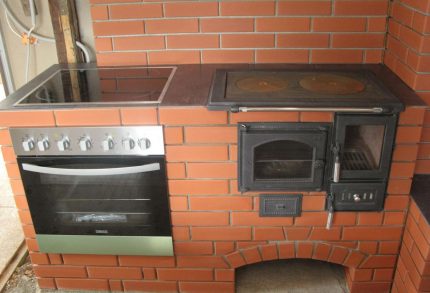
To think over this moment is better when designing a house. A heating stove can become an object dividing a large room into several separate zones. Each of them will be warm.
With a hob, they act completely differently. In a closed kitchen, it is best to place it close to two adjacent outer walls. This will allow the transfer of excess thermal energy to the outside so that the room does not overheat during cooking.
Cooking ovens are set separately, in the open air. This is a popular element of the recreation area. Barbecue, barbecue, cauldron and other cooking appliances can be located nearby. On a cool evening, the heat from such an oven will pleasantly warm vacationers.
A combination oven, like a cooking stove, is placed near two walls, but it is better if they are internal. Then the heat will go not to the street, but to the house, and the kitchen will be moderately warm. The chimney is made massive, as for heating, but it is shifted towards the living rooms. As a result, thermal energy is distributed evenly throughout the house.
Preparation for work
For laying a stove with a stove, different types of bricks are used. Usually they take red solid for outdoor masonry and fireclay - to perform the inner lining of the furnace, as well as the smoke well.
The foundation is poured with concrete mortar. To prepare it, you will need cement not lower than M400, better - M500. The sand may be river or from the quarry, but it must first be sieved to prevent ingress of impurities. Water should also be taken clean. Another solution should be taken granite crushed stone about 30 mm.
The foundation is filled with rubble granite, a suitable fraction of about 300 mm. In addition, you will need to prepare a solution of red clay and sand.
Instead of clay, you can buy clay powder, the order of its use is indicated on the packaging. All components must be of good quality, the integrity and service life of the future stove depends on this. To seal joints, you need to prepare high temperature sealant.
The work is performed using a conventional building tool.
You may need:
- containers for mixing the solution;
- Master OK;
- Bulgarian;
- plumb line;
- level;
- roulette;
- rule
- mallet;
- stove hammer;
- other devices for processing and laying brick.
To make a quality mortar, it is better to use a hammer drill or drill with the appropriate characteristics, as well as a nozzle designed for these purposes. A shovel and sieve will come in handy.
Wood stove construction
After the type of device is selected, materials are prepared and a suitable place is selected, you can begin work.
The process of creating a wood stove is conventionally divided into three stages:
- Foundation construction.
- The construction of the furnace itself.
- Creating a chimney design.
All work should be done clearly by technology. During operation, such a device heats up and is subjected to high loads. Even a small mistake in the future can turn into big problems. If in doubt, it is best to consult an experienced stove maker.
Separate foundation device
The base for the furnace should not be connected to the strip or column foundation of the house. The device is heavy, it will upset the base more strongly than the walls and roof. Therefore, even at the design stage, this point must be taken into account.
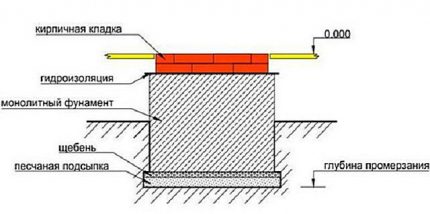
If the house is already built, but the stove is still needed, you will have to open the floor, get to the ground and fill in a separate base. An exception is the monolithic foundation, its bearing capacity will withstand such an additional load without noticeable deformations.
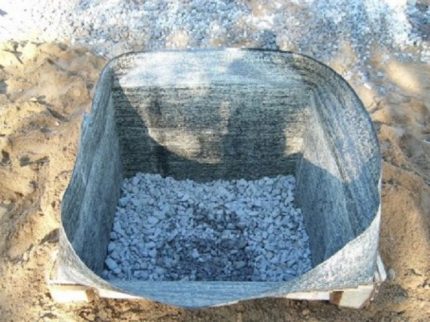
First they dig a pit of the same shape as the base of the furnace, but a little larger, about 20 cm for each side, and a depth of about half a meter.

After that, perform the following operations:
- The soil at the bottom is carefully leveled and compacted.
- A layer of sand is poured to the bottom, it is also tamped and moistened, the recommended thickness of the sand cushion is about 90 mm.
- Lay sheets of roofing material on the walls, this is a waterproofing layer.
- If necessary, roofing material is strengthened with the help of boards and bricks, which act as formwork.
- A layer of crushed stone is poured and compacted onto the sand.
- A reinforcing mesh is made of a metal bar, a wire is used for knitting.
- A solution consisting of cement with the addition of sand and crushed stone in a ratio of 2: 1: 2 is poured into a third of the remaining height.
- The next cement-sand layer is poured (3: 1), leaving about five centimeters to the top of the pit.
- After that, lay another layer of the same mixture to the very top.
- The screed is aligned with the rule.
Now you need to wait about four weeks for the fresh foundation to freeze well.
It is recommended to moisten the surface of the base with water daily and cover it with a film layer so that the process runs evenly.

After this, the formwork is removed, and the upper part of the base is covered with two or three layers of roofing material, which are glued with bitumen mastic. Waterproofing will protect the stove body from contact with moisture from the ground. The bottom layer of the foundation, if desired, can be made of cement and gravel, the recommended proportion is one to three.
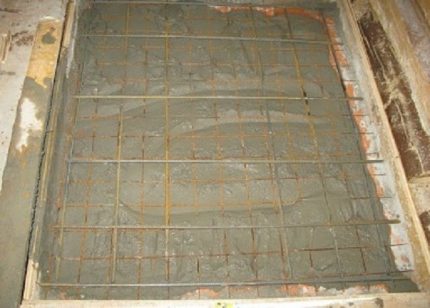
If the roofing material was not at hand, ordinary boards are suitable for the formwork, but they need to be covered with a plastic film to protect it from water. It is best to build the foundation under the stove to the floor level or even slightly higher. It’s easier to do the finishing work.
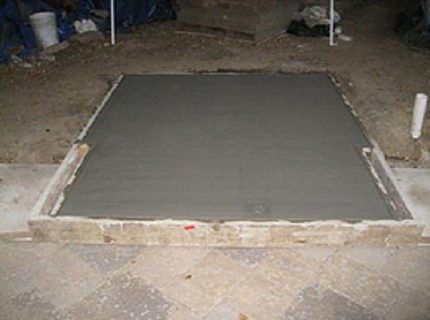
The part that rises above the floor, usually do a little more, for this the formwork is expanded. It also does not hurt to perform a separate reinforcement of the upper layer - a mesh with a pitch of about 75 mm will do.
Masonry order
To understand how to correctly lay a simple stove with a stove, the so-called dry masonry is first performed, i.e. lay bricks in rows, according to the plan, but without mortar. Instead, use pieces of plywood, slats or planks of a suitable size. The space between the individual rows should be the same.
If the brick lay down correctly, the dry masonry is dismantled, after which the masonry mortar is prepared and work is performed with it. The easiest way to use clay powder from the store. You just need to dilute it correctly according to the instructions and add sand.
Clay is a little more complicated. To begin with, you need to soak it with water for about a day. After that, sand is added to the mixture of water and clay in small portions and knead the composition with your hands to a homogeneous state. The amount of sand depends on how greasy clay is used.
As a result, the resulting mixture will become thick enough not to drain from the shovel, but to slide off it. In addition, the composition must not adhere to a metal tool. If the resulting mixture meets these characteristics, you can start laying. Here is an example diagram for a small combi oven.
First, marking is applied to the roofing material glued to the base.
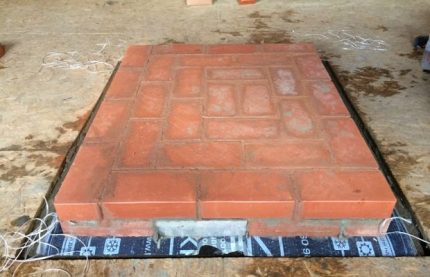
The first two rows are made continuous, while the vertical joints between whole bricks in adjacent rows should not coincide.
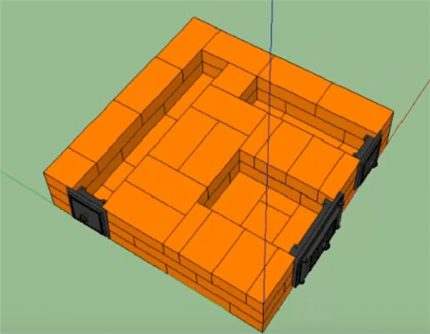
The next two rows are made with gaps for the blower and holes for cleaning the chimney. The openings are closed with metal doors.
Doors should be prepared before installation: drill holes in the corners, insert pieces of wire into them and wrap the frame with asbestos cord. Pieces of wire are laid in a solution between bricks.
The fourth row is made of fireclay bricks, since the firebox is already starting here. Part of the height of the brick is chosen, a grate is placed above the opening.
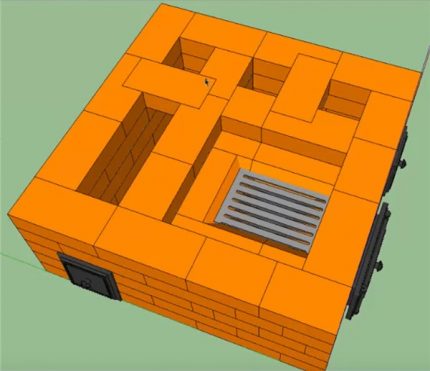
The fifth row is performed in the same way as the fourth. From the sixth to the eighth masonry continue to repeat, but leave a gap for the door of the combustion chamber.
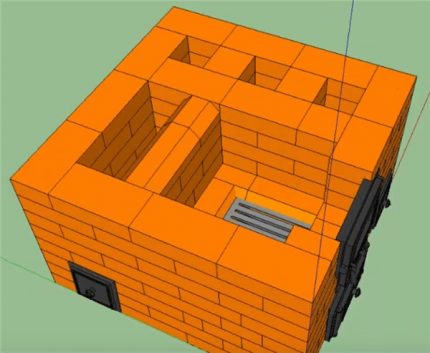
The row above the firebox door will become the base for the stove. Part of the brick around the perimeter is removed, laid with an asbestos cord and a cast-iron hob is placed on top.

If everything is done correctly, the stove and the upper side of the ninth row of bricks will be on the same level.
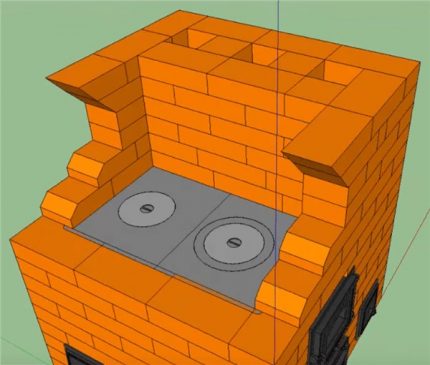
Next, they continue to lay out the side walls and the chimney channel. This will take about six or seven more rows. The next row should also include a visor hanging over the stove. To strengthen it, use a steel corner.
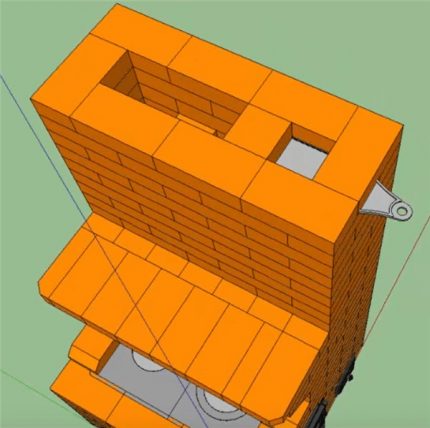
It remains to lay out the chimney, its height is nine bricks. In this example, on the sixth row of nine, they stopped laying the partition between the left and middle channels. Thus, a gap was created for the free movement of smoke.
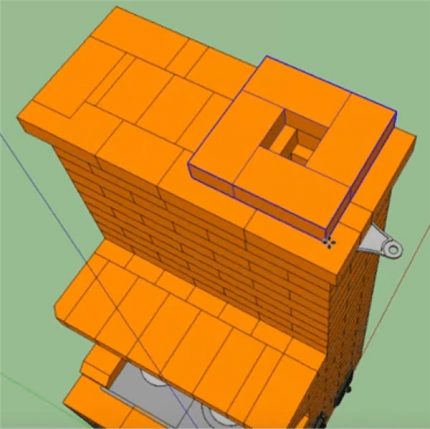
Now we need a solid masonry over the left and central channels.
In the right smoke channel in front of the last row of bricks, a gate is inserted and a gap is left for the chimney.
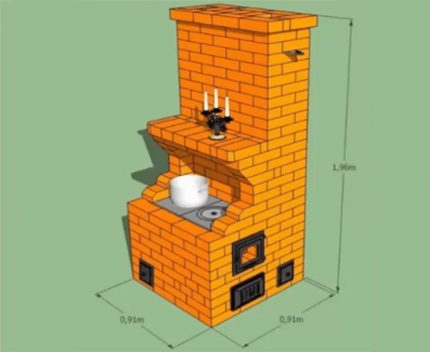
It remains only to equip the chimney and perform facing work, if necessary.
Important nuances and tips
Experienced stove makers sometimes ignore the dry masonry stage, but for beginners it is required. This will help to understand the internal structure of the stove, all its channels and cavities in order to prevent possible errors.
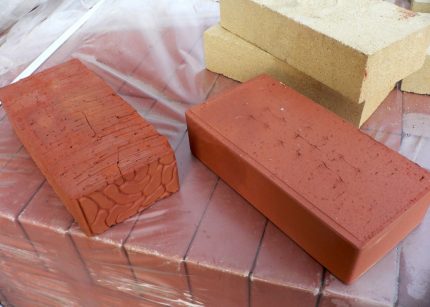
In almost every row, some bricks are customized in size.Experienced stove makers advise folding the elements of each row separately when disassembling dry masonry. You can also take a marker and put a row number and a place number of an element in the masonry on each brick.
Instead of mortar in dry masonry, it is most convenient to use wooden slats of the same thickness. They will be useful in the future to control the amount of mortar between the bricks.
The work is performed as follows:
- Each row during the “wet” masonry is first laid out dry to once again check the position of all the elements.
- On the bottom row, narrow rails, which were used earlier, are placed on the sides.
- A layer of a solution of about 10-12 mm thick is applied on top.
- Lay a brick and beat it with a rubber hammer until it settles on the mortar to the level of the rails.
- The masonry is continued in the same way.
- After removing the slats, the resulting cavities are filled with a solution.
- The resulting fresh seam must be immediately embroidered to give the masonry an aesthetic appearance.
Reiki is taken out only when the row is the third or fourth from above. Now they can be reused. For work, you will need about four sets of such rails.
Each row that is laid on the solution should be checked by level and plumb to the position relative to the horizontal and vertical.
Chipped brick cannot be used in the masonry of parts of the furnace subjected to constant temperature loads. In general, it is undesirable to use elements with cracks and chips in the construction of the massif and chimney. Chipped brick is allowed to be used only in the filling of the base under the foundation of the stove.
The old brick obtained by disassembling the destroyed structures is suitable for laying the foundation, if it is not badly damaged.
The quality of the masonry largely depends on the adhesion strength of the brick and mortar.
To improve this moment, experienced craftsmen recommend:
- Before laying, the red brick is soaked for 7-10 minutes. Fireclay need only dip in water and shake off the drops.
- Lay the brick in place with one clear motion, without shifting or tapping it.
- Apply only the required amount of mortar to the place of masonry. Seams with an array should not be more than 5 mm, in the firebox - no more than 3 mm.
- In the process of laying, you need to “mop”, i.e. rub the inner surface of the chimney sweeps and chambers with a stiff brush to create the smoothest surface along the path of the flue gas flow.
If it was not possible to immediately put the brick in place, the element itself and the place where it is installed should be completely cleaned of the mortar and the masonry should be done on a fresh layer of the mortar.
When laying the pipe, it is allowed to use only red solid brick, which tolerates the effects of acid deposits and temperature changes. The smoother the inner surface of the chimney, the better the draft and less blockages. It is possible to process the inside of the pipe with liquid glass.
On our site there are articles with a detailed description of the technology of construction of different types of brick kilns, we recommend that you read:
- Do-it-yourself mini Russian stove: specifics and arrangements for the construction of a compact stove
- DIY do-it-yourself stoves: construction manuals with diagrams and procedures
Useful video on the topic
The scheme for creating a small heating and cooking stove:
The construction of a furnace equipped with a drying chamber, according to the drawings of Proskurin:
The laying of the furnace does not endure hustle and bustle. It is necessary to think over and carefully carry out each stage of the work in order to obtain the desired result. Better to start with a small design, as described above. Having gained experience, you can proceed to the construction of more complex furnaces: with an oven, a drying chamber, arched openings, etc.
Have experience building a stove with a stove? Please tell readers about the technical nuances of arranging the foundation and laying the solid fuel unit. Comment on the publication, participate in discussions and add photos of your homemade products.The feedback block is located below.

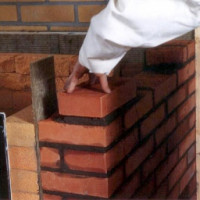 DIY masonry: a detailed guide + orders with diagrams and drawings
DIY masonry: a detailed guide + orders with diagrams and drawings 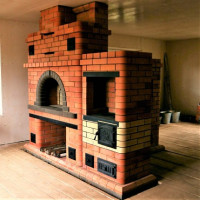 Russian stove with stove: masonry technology of the Russian stove with diagrams and detailed procedures
Russian stove with stove: masonry technology of the Russian stove with diagrams and detailed procedures 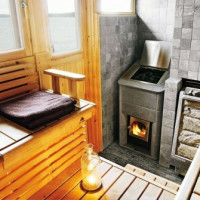 Do-it-yourself gas bath stove: manual for the installation and installation of a gas stove
Do-it-yourself gas bath stove: manual for the installation and installation of a gas stove 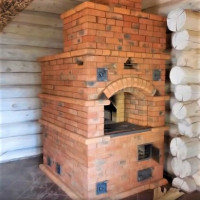 Do-it-yourself mini Russian stove: specifics and arrangements for the construction of a compact stove
Do-it-yourself mini Russian stove: specifics and arrangements for the construction of a compact stove 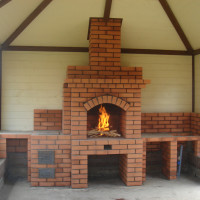 Brick stoves for giving on wood: the best orders and a step-by-step guide to the construction
Brick stoves for giving on wood: the best orders and a step-by-step guide to the construction 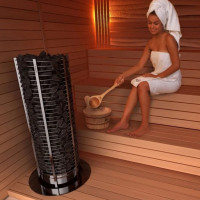 Electric furnace for saunas and baths: TOP-12 of the best models + recommendations for customers
Electric furnace for saunas and baths: TOP-12 of the best models + recommendations for customers  How much does it cost to connect gas to a private house: the price of organizing gas supply
How much does it cost to connect gas to a private house: the price of organizing gas supply  The best washing machines with dryer: model rating and customer tips
The best washing machines with dryer: model rating and customer tips  What is the color temperature of light and the nuances of choosing the temperature of the lamps to suit your needs
What is the color temperature of light and the nuances of choosing the temperature of the lamps to suit your needs  Replacement of a geyser in an apartment: replacement paperwork + basic norms and requirements
Replacement of a geyser in an apartment: replacement paperwork + basic norms and requirements
It is necessary to wet the brick. Firstly, the water will wash off the dust and improve adhesion to the solution. And secondly, raw brick will not take water from the solution. It will dry more slowly and become stronger. But clay is not all suitable. Before, stove-makers were not lazy to go a few tens of kilometers to get the right one. Unfortunately, it is impossible to determine the quality of clay “by eye”. You need either experience or a hint from a specialist.